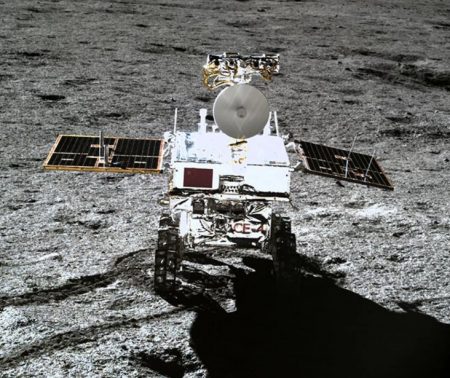January 12, 2019 – It keeps on getting more interesting in space these days as NASA breezes by a duo-planetoid 1.6 billion kilometers past Pluto, begins circling the asteroid Bennu with plans to grab a surface sample to return to Earth, Juno keeps doing flybys of the upper atmosphere of Jupiter sending us pictures that you want to hang on your walls as pieces of art, and China soft lands a mission on the hemisphere of the Moon we never see, colloquially known as the Dark Side.
The only reason it has been referred to as the Dark Side is that the Moon is in tidal lock with Earth, always presenting the same face to us down here. But in fact, the side that faces away receives just as much sunlight as our side. We just never see it unless we send a spacecraft to view what’s back there and send us pictures. There have been lots of those, so many in fact, that we have created detailed maps and named most if not all of the geological features found there. And China chose one of those named areas for its first attempt at landing on the never seen side.
This was a first for any spacefaring nation. Landing on January 2, 2019, the spacecraft touched down in the Von Kármán crater (named after a Hungarian scientist), 186 kilometers in diameter, and located in proximity to the Moon’s South Pole. The Von Kármán crater is part of a much larger impact zone stretching more than 2,500 kilometers and is one of the oldest geological features on the Moon. This area of our celestial neighbour witnessed several basaltic flooding events in the Moon’s early history creating what is referred to as a basin-scale impact melt deposit. Chang’e 4 should have a field day studying the composition of the surface of the crater as it samples the regolith and gathers a ton of data.
Since its soft landing, the spacecraft has unleashed its rover named Yuta 2, or Jade Rabbit 2. The rover is the second one that China has put on the Moon. The first called Yuta, explored an area of the Moon we see in 2013 for 973 days before falling silent.
This rover is carrying a bevy of scientific instruments including:
- VNIS, the Visible Near-Infrared Spectrometer,
- PCam, a Panoramic Camera,
- LPR, a Lunar Penetrating Radar,
- and a unique biological experiment with eggs of silkworms, and seeds from a number of plant species, including potatoes. The Chinese scientists want to monitor how the lunar environment impacts biological growth.
Some interesting facts about the Moon’s other side. The lunar crust is thicker and contains less potassium and phosphorus. Scientists don’t know why. The far side is also considerably rougher with the exception being the Von Kármán crater seen in the image below.

To ensure continuous communication between Chang’e 4, Yuta 2, and Earth’s ground stations, China placed a bridge relay communication satellite, Queqiao, in orbit around the Moon in June of 2018. We should be able to get a continuous feed of data and images over the coming months and learn a little bit more about a side of our nearest celestial neighbour, a side that has kept us in the dark for years, but certainly not a Dark Side.
The lander and rover shortly after arrival hunkered down to protect their instrumentation from the heat of the 14-Earth-day long lunar day where temperatures at high noon exceed 100 Celsius (212 Fahrenheit). But two days ago both lander and rover awakened.
NASA’s Lunar Reconnaissance Orbiter will fly over the Change’e 4 landing site on January 31st and maybe give us a “birds-eye” satellite view of the site. It should make for an interesting picture. Meanwhile, you can check out Yutu 2 in the picture below.










